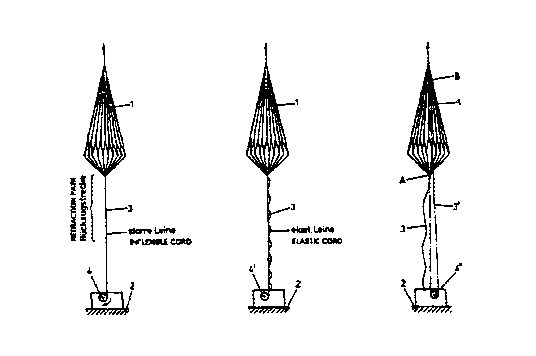Some of the information on this Web page has been provided by external sources. The Government of Canada is not responsible for the accuracy, reliability or currency of the information supplied by external sources. Users wishing to rely upon this information should consult directly with the source of the information. Content provided by external sources is not subject to official languages, privacy and accessibility requirements.
Any discrepancies in the text and image of the Claims and Abstract are due to differing posting times. Text of the Claims and Abstract are posted:
| (12) Patent Application: | (11) CA 2324362 |
|---|---|
| (54) English Title: | METHOD FOR DEPLOYING AN EMERGENCY PARACHUTE AND PARACHUTE SYSTEM COMPRISING A PARACHUTE DEPLOYED ACCORDING TO SAID METHOD |
| (54) French Title: | PROCEDE POUR L'OUVERTURE D'UN PARACHUTE DE SAUVETAGE ET SYSTEME DE PARACHUTE MUNI D'UN PARACHUTE ACTIONNE SELON CE PROCEDE |
| Status: | Deemed Abandoned and Beyond the Period of Reinstatement - Pending Response to Notice of Disregarded Communication |
| (51) International Patent Classification (IPC): |
|
|---|---|
| (72) Inventors : |
|
| (73) Owners : |
|
| (71) Applicants : |
|
| (74) Agent: | ROBIC AGENCE PI S.E.C./ROBIC IP AGENCY LP |
| (74) Associate agent: | |
| (45) Issued: | |
| (86) PCT Filing Date: | 1999-03-09 |
| (87) Open to Public Inspection: | 1999-10-07 |
| Availability of licence: | N/A |
| Dedicated to the Public: | N/A |
| (25) Language of filing: | English |
| Patent Cooperation Treaty (PCT): | Yes |
|---|---|
| (86) PCT Filing Number: | PCT/CH1999/000108 |
| (87) International Publication Number: | WO 1999050142 |
| (85) National Entry: | 2000-09-19 |
| (30) Application Priority Data: | ||||||
|---|---|---|---|---|---|---|
|
The invention relates to a method for rapidly deploying an emergency
parachute. According to said method, at the latest at the end of the blast-off
path the parachute (1) is jerked backward in the direction of the object which
has to be decelerated and landed. This causes the parachute to open
immediately. The method allows for the use of such parachutes even close to
the ground.
L'invention concerne un procédé assurant l'ouverture rapide d'un parachute de sauvetage, dans lequel on rétracte le parachute par saccades dans le sens de l'objet qu'il faut faire atterrir en freinant, au plus tard à la fin de la distance d'éloignement par propulsion. Ainsi, le parachute s'ouvre immédiatement. Grâce à ce procédé, on peut également utiliser de tels parachutes à proximité du sol.
Note: Claims are shown in the official language in which they were submitted.
Note: Descriptions are shown in the official language in which they were submitted.

2024-08-01:As part of the Next Generation Patents (NGP) transition, the Canadian Patents Database (CPD) now contains a more detailed Event History, which replicates the Event Log of our new back-office solution.
Please note that "Inactive:" events refers to events no longer in use in our new back-office solution.
For a clearer understanding of the status of the application/patent presented on this page, the site Disclaimer , as well as the definitions for Patent , Event History , Maintenance Fee and Payment History should be consulted.
| Description | Date |
|---|---|
| Application Not Reinstated by Deadline | 2003-03-10 |
| Time Limit for Reversal Expired | 2003-03-10 |
| Deemed Abandoned - Failure to Respond to Maintenance Fee Notice | 2002-03-11 |
| Inactive: Cover page published | 2000-12-21 |
| Inactive: First IPC assigned | 2000-12-19 |
| Letter Sent | 2000-12-14 |
| Inactive: Notice - National entry - No RFE | 2000-12-14 |
| Application Received - PCT | 2000-12-04 |
| Application Published (Open to Public Inspection) | 1999-10-07 |
| Abandonment Date | Reason | Reinstatement Date |
|---|---|---|
| 2002-03-11 |
The last payment was received on 2001-02-13
Note : If the full payment has not been received on or before the date indicated, a further fee may be required which may be one of the following
Please refer to the CIPO Patent Fees web page to see all current fee amounts.
| Fee Type | Anniversary Year | Due Date | Paid Date |
|---|---|---|---|
| Registration of a document | 2000-09-19 | ||
| Basic national fee - small | 2000-09-19 | ||
| MF (application, 2nd anniv.) - small | 02 | 2001-03-09 | 2001-02-13 |
Note: Records showing the ownership history in alphabetical order.
| Current Owners on Record |
|---|
| FRICK AEROTECH AG |
| Past Owners on Record |
|---|
| ALEXANDER FRICK |